Abstract
All cells contain elaborate systems for the spatial and temporal regulation of the calcium ion, [Ca2+]i, and diverse Ca2+ receptor and biochemical response systems that are regulated by these changes in [Ca2+]i. Toxicants that perturb the mobilization or homeostasis of [Ca2+]i will place the regulation of these processes outside the normal range of physiological control. Many classes of chemical toxicants, including metals, solvents, and pesticides, may have particular aspects of cell calcium as key cellular and molecular targets of toxicant action. However, experimental proof of these targets as a specific site of toxicant action is challenging and technically difficult as a result of the complexity and diversity of these processes. To fully establish and understand the target role of the calcium messenger system in toxicant action, it is necessary to distinguish between the effects of a toxicant on (a) the calcium mobilization and homeostatic processes, (b) the calcium-mediated processes, and (c) from those processes which co-regulate or counter-regulate these calcium-mediated processes. As our understanding of the calcium messenger system expands, these insights will be increasingly applied to understanding the mechanisms of action of toxic chemicals.
Full text
PDF

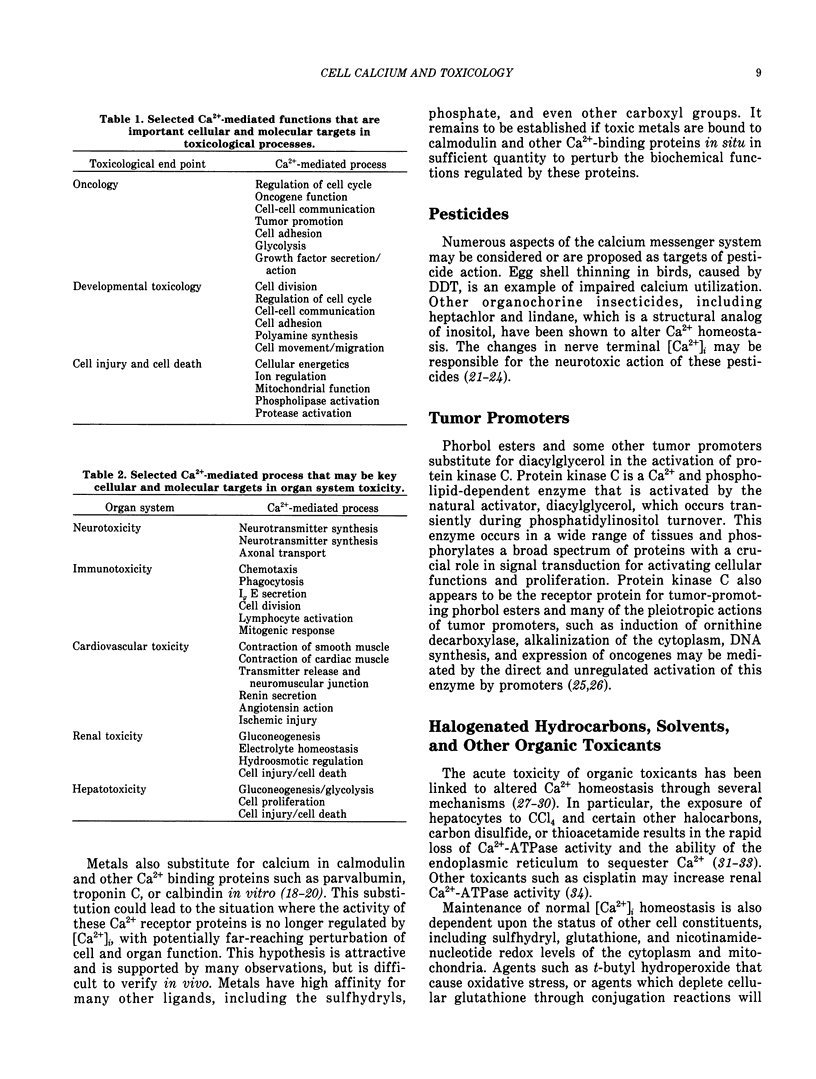
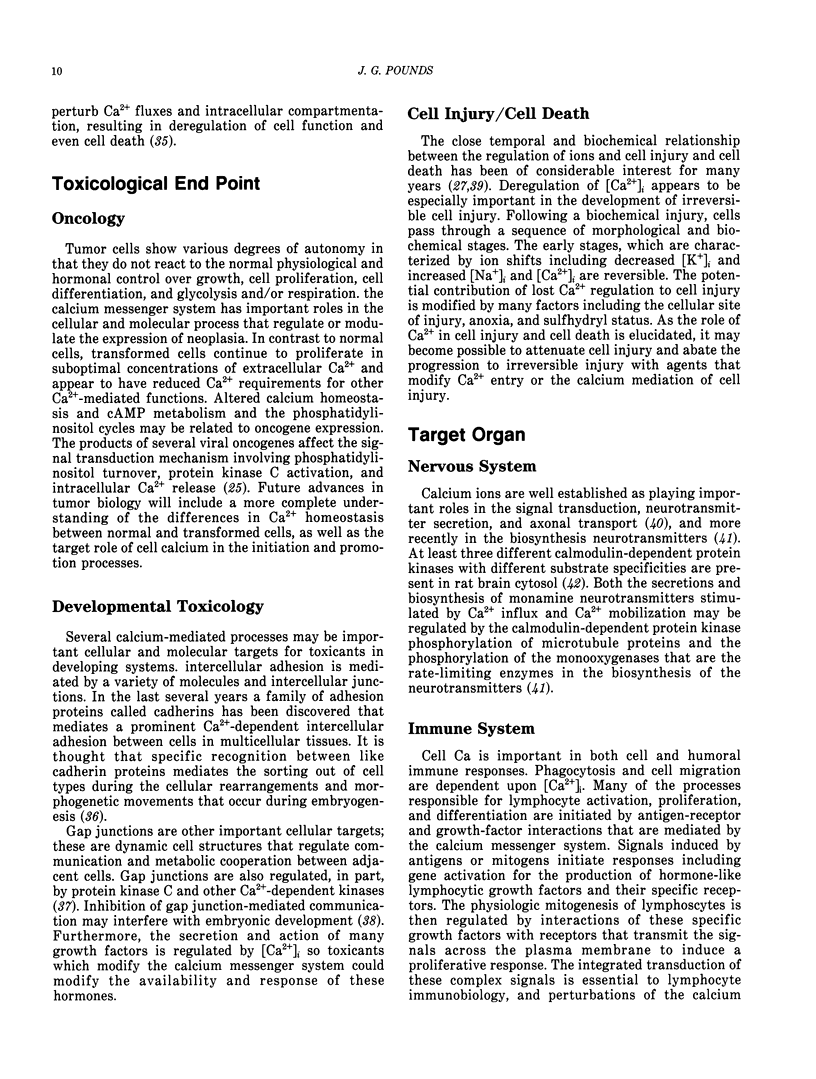
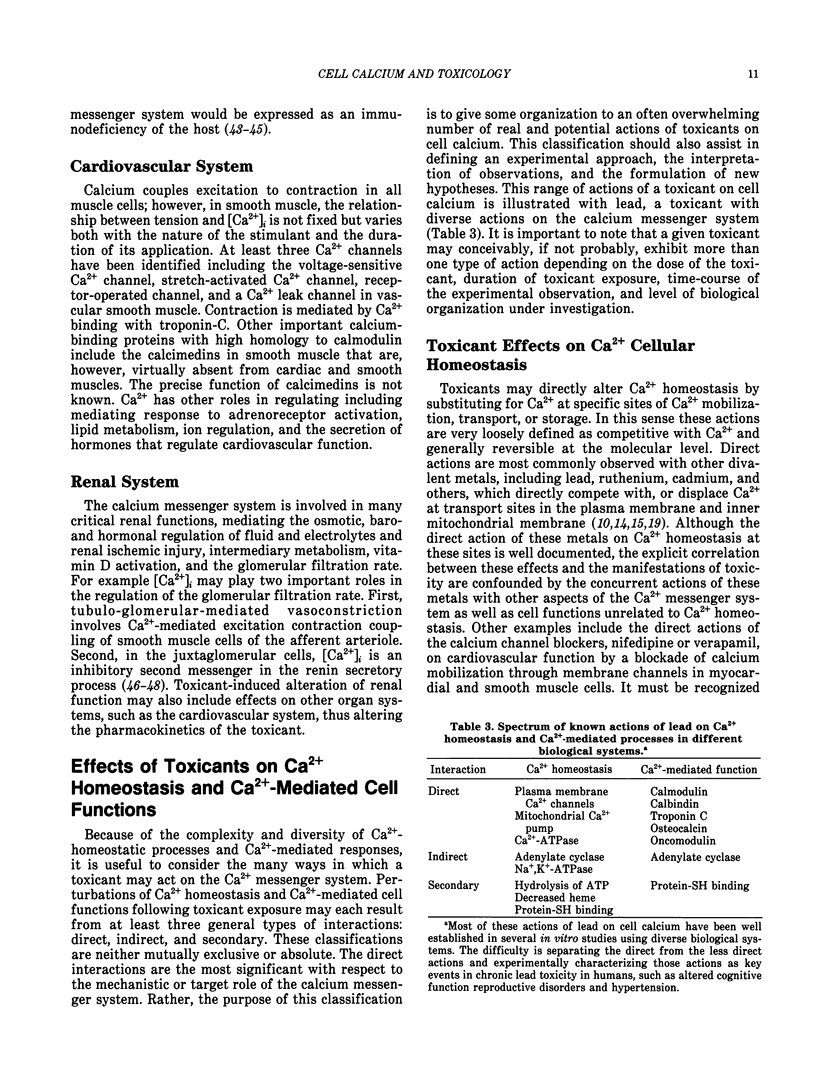

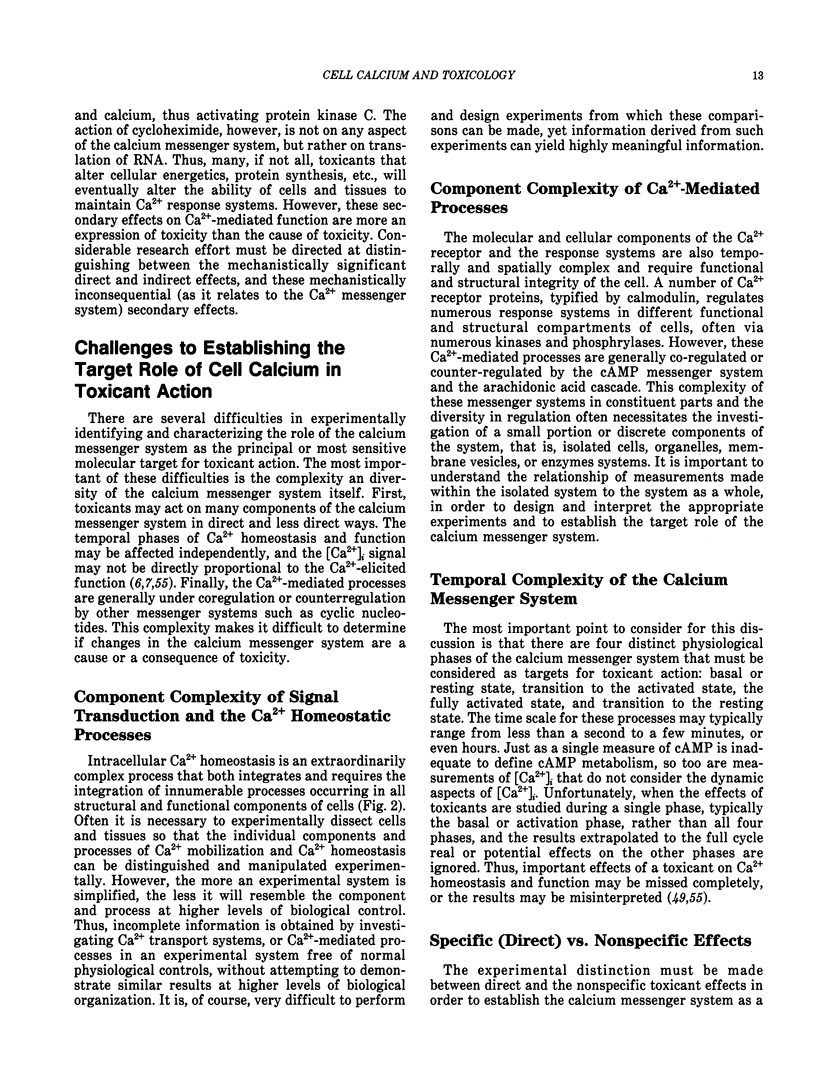
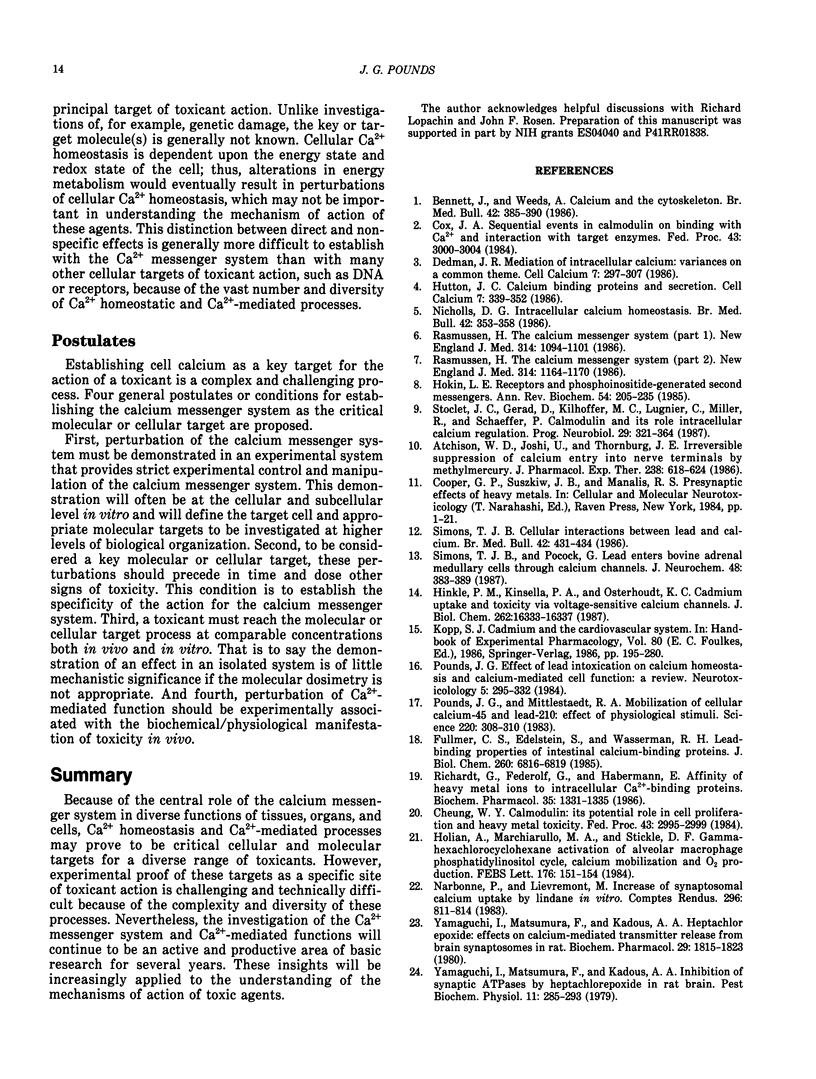
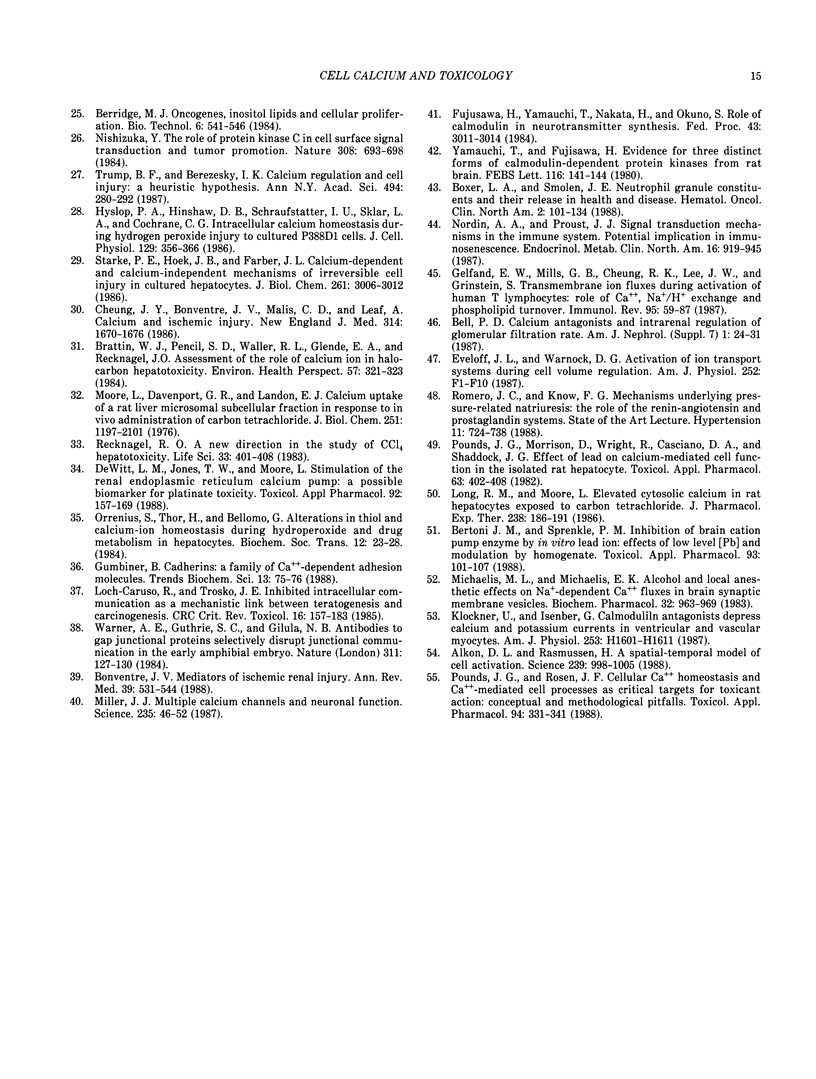
Selected References
These references are in PubMed. This may not be the complete list of references from this article.
- Alkon D. L., Rasmussen H. A spatial-temporal model of cell activation. Science. 1988 Feb 26;239(4843):998–1005. doi: 10.1126/science.2830669. [DOI] [PubMed] [Google Scholar]
- Atchison W. D., Joshi U., Thornburg J. E. Irreversible suppression of calcium entry into nerve terminals by methylmercury. J Pharmacol Exp Ther. 1986 Aug;238(2):618–624. [PubMed] [Google Scholar]
- Bell P. D. Calcium antagonists and intrarenal regulation of glomerular filtration rate. Am J Nephrol. 1987;7 (Suppl 1):24–31. doi: 10.1159/000167539. [DOI] [PubMed] [Google Scholar]
- Bennett J., Weeds A. Calcium and the cytoskeleton. Br Med Bull. 1986 Oct;42(4):385–390. doi: 10.1093/oxfordjournals.bmb.a072156. [DOI] [PubMed] [Google Scholar]
- Bertoni J. M., Sprenkle P. M. Inhibition of brain cation pump enzyme by in vitro lead ion: effects of low level [Pb] and modulation by homogenate. Toxicol Appl Pharmacol. 1988 Mar 30;93(1):101–107. doi: 10.1016/0041-008x(88)90029-4. [DOI] [PubMed] [Google Scholar]
- Bonventre J. V. Mediators of ischemic renal injury. Annu Rev Med. 1988;39:531–544. doi: 10.1146/annurev.me.39.020188.002531. [DOI] [PubMed] [Google Scholar]
- Boxer L. A., Smolen J. E. Neutrophil granule constituents and their release in health and disease. Hematol Oncol Clin North Am. 1988 Mar;2(1):101–134. [PubMed] [Google Scholar]
- Brattin W. J., Pencil S. D., Waller R. L., Glende E. A., Jr, Recknagel R. O. Assessment of the role of calcium ion in halocarbon hepatotoxicity. Environ Health Perspect. 1984 Aug;57:321–323. doi: 10.1289/ehp.8457321. [DOI] [PMC free article] [PubMed] [Google Scholar]
- Cheung J. Y., Bonventre J. V., Malis C. D., Leaf A. Calcium and ischemic injury. N Engl J Med. 1986 Jun 26;314(26):1670–1676. doi: 10.1056/NEJM198606263142604. [DOI] [PubMed] [Google Scholar]
- Cheung W. Y. Calmodulin: its potential role in cell proliferation and heavy metal toxicity. Fed Proc. 1984 Dec;43(15):2995–2999. [PubMed] [Google Scholar]
- Cox J. A. Sequential events in calmodulin on binding with calcium and interaction with target enzymes. Fed Proc. 1984 Dec;43(15):3000–3004. [PubMed] [Google Scholar]
- De Witt L. M., Jones T. W., Moore L. Stimulation of the renal endoplasmic reticulum calcium pump: a possible biomarker for platinate toxicity. Toxicol Appl Pharmacol. 1988 Feb;92(2):157–169. doi: 10.1016/0041-008x(88)90376-6. [DOI] [PubMed] [Google Scholar]
- Dedman J. R. Mediation of intracellular calcium: variances on a common theme. Cell Calcium. 1986 Dec;7(5-6):297–307. doi: 10.1016/0143-4160(86)90034-5. [DOI] [PubMed] [Google Scholar]
- Eveloff J. L., Warnock D. G. Activation of ion transport systems during cell volume regulation. Am J Physiol. 1987 Jan;252(1 Pt 2):F1–10. doi: 10.1152/ajprenal.1987.252.1.F1. [DOI] [PubMed] [Google Scholar]
- Fujisawa H., Yamauchi T., Nakata H., Okuno S. Role of calmodulin in neurotransmitter synthesis. Fed Proc. 1984 Dec;43(15):3011–3014. [PubMed] [Google Scholar]
- Fullmer C. S., Edelstein S., Wasserman R. H. Lead-binding properties of intestinal calcium-binding proteins. J Biol Chem. 1985 Jun 10;260(11):6816–6819. [PubMed] [Google Scholar]
- Gelfand E. W., Mills G. B., Cheung R. K., Lee J. W., Grinstein S. Transmembrane ion fluxes during activation of human T lymphocytes: role of Ca2+, Na+/H+ exchange and phospholipid turnover. Immunol Rev. 1987 Feb;95:59–87. doi: 10.1111/j.1600-065x.1987.tb00500.x. [DOI] [PubMed] [Google Scholar]
- Gumbiner B. Cadherins: a family of Ca2+-dependent adhesion molecules. Trends Biochem Sci. 1988 Mar;13(3):75–76. doi: 10.1016/0968-0004(88)90040-0. [DOI] [PubMed] [Google Scholar]
- Hinkle P. M., Kinsella P. A., Osterhoudt K. C. Cadmium uptake and toxicity via voltage-sensitive calcium channels. J Biol Chem. 1987 Dec 5;262(34):16333–16337. [PubMed] [Google Scholar]
- Hokin L. E. Receptors and phosphoinositide-generated second messengers. Annu Rev Biochem. 1985;54:205–235. doi: 10.1146/annurev.bi.54.070185.001225. [DOI] [PubMed] [Google Scholar]
- Holian A., Marchiarullo M. A., Stickle D. F. gamma-Hexachlorocyclohexane activation of alveolar macrophage phosphatidylinositol cycle, calcium mobilization of O2- production. FEBS Lett. 1984 Oct 15;176(1):151–154. doi: 10.1016/0014-5793(84)80930-8. [DOI] [PubMed] [Google Scholar]
- Hutton J. C. Calcium-binding proteins and secretion. Cell Calcium. 1986 Dec;7(5-6):339–352. doi: 10.1016/0143-4160(86)90037-0. [DOI] [PubMed] [Google Scholar]
- Hyslop P. A., Hinshaw D. B., Schraufstätter I. U., Sklar L. A., Spragg R. G., Cochrane C. G. Intracellular calcium homeostasis during hydrogen peroxide injury to cultured P388D1 cells. J Cell Physiol. 1986 Dec;129(3):356–366. doi: 10.1002/jcp.1041290314. [DOI] [PubMed] [Google Scholar]
- Klöckner U., Isenberg G. Calmodulin antagonists depress calcium and potassium currents in ventricular and vascular myocytes. Am J Physiol. 1987 Dec;253(6 Pt 2):H1601–H1611. doi: 10.1152/ajpheart.1987.253.6.H1601. [DOI] [PubMed] [Google Scholar]
- Loch-Caruso R., Trosko J. E. Inhibited intercellular communication as a mechanistic link between teratogenesis and carcinogenesis. Crit Rev Toxicol. 1985;16(2):157–183. doi: 10.3109/10408448509056269. [DOI] [PubMed] [Google Scholar]
- Long R. M., Moore L. Elevated cytosolic calcium in rat hepatocytes exposed to carbon tetrachloride. J Pharmacol Exp Ther. 1986 Jul;238(1):186–191. [PubMed] [Google Scholar]
- Michaelis M. L., Michaelis E. K. Alcohol and local anesthetic effects on Na+-dependent Ca2+ fluxes in brain synaptic membrane vesicles. Biochem Pharmacol. 1983 Mar 15;32(6):963–969. doi: 10.1016/0006-2952(83)90612-3. [DOI] [PubMed] [Google Scholar]
- Miller R. J. Multiple calcium channels and neuronal function. Science. 1987 Jan 2;235(4784):46–52. doi: 10.1126/science.2432656. [DOI] [PubMed] [Google Scholar]
- Moore L., Rodman Davenport G., Landon E. J. Calcium uptake of a rat liver microsomal subcellular fraction in response to in vivo administration of carbon tetrachloride. J Biol Chem. 1976 Feb 25;251(4):1197–1201. [PubMed] [Google Scholar]
- Narbonne P., Lievremont M. Mise en évidence in vitro d'unme action du lindane sur des préparations de synaptosomes isolés. C R Seances Acad Sci III. 1983;296(17):811–814. [PubMed] [Google Scholar]
- Nicholls D. G. Intracellular calcium homeostasis. Br Med Bull. 1986 Oct;42(4):353–358. doi: 10.1093/oxfordjournals.bmb.a072152. [DOI] [PubMed] [Google Scholar]
- Nishizuka Y. The role of protein kinase C in cell surface signal transduction and tumour promotion. Nature. 1984 Apr 19;308(5961):693–698. doi: 10.1038/308693a0. [DOI] [PubMed] [Google Scholar]
- Nordin A. A., Proust J. J. Signal transduction mechanisms in the immune system. Potential implication in immunosenescence. Endocrinol Metab Clin North Am. 1987 Dec;16(4):919–945. [PubMed] [Google Scholar]
- Orrenius S., Thor H., Bellomo G. Alterations in thiol and calcium-ion homoeostasis during hydroperoxide and drug metabolism in hepatocytes. Biochem Soc Trans. 1984 Feb;12(1):23–28. doi: 10.1042/bst0120023. [DOI] [PubMed] [Google Scholar]
- Pounds J. G. Effect of lead intoxication on calcium homeostasis and calcium-mediated cell function: a review. Neurotoxicology. 1984 Fall;5(3):295–331. [PubMed] [Google Scholar]
- Pounds J. G., Mittelstaedt R. A. Mobilization of cellular calcium-45 and lead-210: effect of physiological stimuli. Science. 1983 Apr 15;220(4594):308–310. doi: 10.1126/science.6301003. [DOI] [PubMed] [Google Scholar]
- Pounds J. G., Morrison D., Wright R., Casciano D. A., Shaddock J. G. Effect of lead on calcium-mediated cell function in the isolated rat hepatocyte. Toxicol Appl Pharmacol. 1982 May;63(3):402–408. doi: 10.1016/0041-008x(82)90269-1. [DOI] [PubMed] [Google Scholar]
- Pounds J. G., Rosen J. F. Cellular Ca2+ homeostasis and Ca2+-mediated cell processes as critical targets for toxicant action: conceptual and methodological pitfalls. Toxicol Appl Pharmacol. 1988 Jul;94(3):331–341. doi: 10.1016/0041-008x(88)90275-x. [DOI] [PubMed] [Google Scholar]
- Rasmussen H. The calcium messenger system (1). N Engl J Med. 1986 Apr 24;314(17):1094–1101. doi: 10.1056/NEJM198604243141707. [DOI] [PubMed] [Google Scholar]
- Rasmussen H. The calcium messenger system (2). N Engl J Med. 1986 May 1;314(18):1164–1170. doi: 10.1056/NEJM198605013141807. [DOI] [PubMed] [Google Scholar]
- Recknagel R. O. A new direction in the study of carbon tetrachloride hepatotoxicity. Life Sci. 1983 Aug 1;33(5):401–408. doi: 10.1016/0024-3205(83)90787-7. [DOI] [PubMed] [Google Scholar]
- Richardt G., Federolf G., Habermann E. Affinity of heavy metal ions to intracellular Ca2+-binding proteins. Biochem Pharmacol. 1986 Apr 15;35(8):1331–1335. doi: 10.1016/0006-2952(86)90278-9. [DOI] [PubMed] [Google Scholar]
- Romero J. C., Knox F. G. Mechanisms underlying pressure-related natriuresis: the role of the renin-angiotensin and prostaglandin systems. State of the art lecture. Hypertension. 1988 Jun;11(6 Pt 2):724–738. doi: 10.1161/01.hyp.11.6.724. [DOI] [PubMed] [Google Scholar]
- Simons T. J. Cellular interactions between lead and calcium. Br Med Bull. 1986 Oct;42(4):431–434. doi: 10.1093/oxfordjournals.bmb.a072162. [DOI] [PubMed] [Google Scholar]
- Simons T. J., Pocock G. Lead enters bovine adrenal medullary cells through calcium channels. J Neurochem. 1987 Feb;48(2):383–389. doi: 10.1111/j.1471-4159.1987.tb04105.x. [DOI] [PubMed] [Google Scholar]
- Starke P. E., Hoek J. B., Farber J. L. Calcium-dependent and calcium-independent mechanisms of irreversible cell injury in cultured hepatocytes. J Biol Chem. 1986 Mar 5;261(7):3006–3012. [PubMed] [Google Scholar]
- Stoclet J. C., Gérard D., Kilhoffer M. C., Lugnier C., Miller R., Schaeffer P. Calmodulin and its role in intracellular calcium regulation. Prog Neurobiol. 1987;29(4):321–364. doi: 10.1016/0301-0082(87)90018-9. [DOI] [PubMed] [Google Scholar]
- Warner A. E., Guthrie S. C., Gilula N. B. Antibodies to gap-junctional protein selectively disrupt junctional communication in the early amphibian embryo. Nature. 1984 Sep 13;311(5982):127–131. doi: 10.1038/311127a0. [DOI] [PubMed] [Google Scholar]
- Yamaguchi I., Matsumura F., Kadous A. A. Heptachlor epoxide: effects on calcium-mediated transmitter release from brain synaptosomes in rat. Biochem Pharmacol. 1980 Jun 15;29(12):1815–1823. doi: 10.1016/0006-2952(80)90144-6. [DOI] [PubMed] [Google Scholar]
- Yamauchi T., Fujisawa H. Evidence for three distinct forms of calmodulin-dependent protein kinases from rat brain. FEBS Lett. 1980 Jul 28;116(2):141–144. doi: 10.1016/0014-5793(80)80628-4. [DOI] [PubMed] [Google Scholar]


